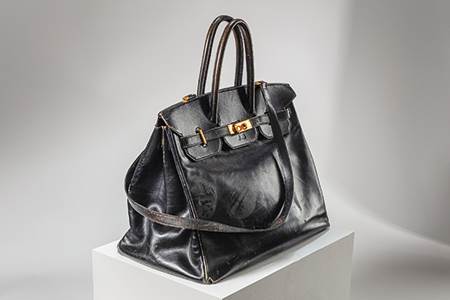Record in the bag

An original prototype of the Hermès Birkin bag has become the most expensive handbag ever to sell at auction.
Almost exactly two years after the death of singer and film star Jane Birkin, the original Birkin bag, named after her, has sold at auction in Paris for a record amount. It has become the most expensive handbag in history to sell at auction. This is a testament to its quality, but also to the circular credentials of the material it is made from, black box calf leather. It is long-lasting and becomes more attractive with age.
Hermès made the first Birkin bag in the 1980s after a famous chance encounter. Jane Birkin was on the same flight from Paris to London as then-chief executive, Jean-Louis Dumas, cousin of current chief executive, Axel Dumas.
She complained that she could not find a tote bag that suited her and was carrying her belongings in a straw basket instead. When she attempted to place the basket in the overhead locker of the aircraft, many of her personal effects fell to the floor. Mr Dumas helped her to pick them up and promised to make something better for her, immediately sketching an initial idea of what might work. The result was the now-famous Birkin bag.
Design elements
Sotheby’s described the original bag as a handmade prototype that included a number of design elements that the Birkin bags that Hermès makes today do not contain. The prototype borrowed from a design that first came to light in the early twentieth century earlier for the Haut à Courroies bag. Hermès was already well known for equestrian products and the idea behind the Haut à Courroies was to offer customers a bag in which to carry around some of the equestrian gear they had bought. Its closed metal rings made their way into the Birkin.
The prototype Birkin also has unusual dimensions: the width and height of the model that became the Birkin 35 and the depth of the Birkin 40. The shoulder-strap on the prototype is non-removable and the support studs on the bottom are smaller than in the now established design. It also has Jane Birkin’s initials embossed into the box calf leather, immediately below the main metal clasp.
In the course of her association with Hermès, the company supplied Jane Birkin with four further bags from the range that bears her name. According to Sotheby’s, she always liked the original prototype the best. She used it until 1994, when she chose to donate it to a charity auction for an AIDS charity in France. The bag sold at auction again in 2000 and only re-emerged at the Sotheby’s sale in July this year, still intact, still beautiful.
Let battle commence
The auction house put the iconic piece on display for the public to view in New York and in Paris leading up to this year’s sale. On the day itself, July 10, what ensued, according to Sotheby’s, was “an electrifying 10-minute bidding battle”. Nine bidders had their eyes on the prize. In the end, a private collector in Japan emerged as the winner, paying a total of $10.1 million, including fees, for the privilege of owning it, a record for a handbag sold at auction.
This came as no surprise to the company’s head of handbags and fashion, Morgane Halimi. She describes the prototype bag as a rare example in the world of fashion of an object that “transcends trends and becomes a legend”. She says: “There is no doubt that the original Birkin bag is a true one-of-a-kind, a singular piece of fashion history that has grown into a pop-culture phenomenon that signals luxury in the most refined way possible.”
Five years’ training
A number of factors contribute to this, most famously the limited supply of bags in the Birkin range. Hermès is a beacon when it comes to employing and training people to make high-end leathergoods. At the end of 2024, the company employed a total of 25,185 people, an increase of 10% year on year. Its products are manufactured at 23 different leather workshops; all of these are located in France. It also has three further sites currently under development.
Even so, only a limited number of its artisans are permitted to work on its most exclusive products, including Birkin bags. Each of these items requires 18 hours’ work to construct. To train a new artisan to produce the bags takes five years, with each person having to attain expertise in all aspects of the product’s creation. This includes cutting leather, stitching and assembly.
Personal relationships
Of course Hermès could make more Birkin bags if it wanted to, but it chooses to preserve the product’s exclusivity. It wants demand to exceed supply. Customers cannot walk through the doors of a store and buy a Birkin and, contrary to urban myth, there is no official waiting list. High-spending regular customers may be given the opportunity to buy one, as a reward for showing brand loyalty. Even then, they may have to wait a year or more for one of the bags to become available. According to an article on this subject that Fortune published in 2024, new customers may never have the chance to buy one.
Much can depend, it seems, on the personal relationships a customer is able to build up with sales representatives. In a sense, this is what Jane Birkin did all those years ago, although opportunities to engage the brand’s chief executive in designing a bag to suit one person’s particular needs clearly only come along rarely.
Special design elements in the original bag include the embossed initials of the original owner, actress and singer Jane Birkin.
Credit: Sotherby’s






























